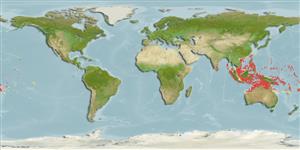>
Eupercaria/misc (Various families in series Eupercaria) >
Malacanthidae (Tilefishes)
Etymology: Hoplolatilus: Greek, hoplon = weapon + Latin, latus = wide (Ref. 45335).
Environment: milieu / climate zone / depth range / distribution range
Ökologie
seewasser riff-verbunden; tiefenbereich 18 - 100 m (Ref. 9710), usually 30 - 80 m (Ref. 27115). Tropical; 22°C - 28°C (Ref. 27115)
Indo-Pacific: Indonesia, Palau, Philippines, Papua New Guinea and Solomon Islands. Recently reported from Tonga (Ref. 53797).
Size / Gewicht / Alter
Maturity: Lm ? range ? - ? cm
Max length : 12.0 cm TL Männchen/unbestimmt; (Ref. 9710); common length : 10.4 cm SL Männchen/unbestimmt; (Ref. 37816)
Rückenflossenstacheln (insgesamt): 9; Rückenflossenweichstrahlen (insgesamt): 16; Afterflossenstacheln 1-2; Afterflossenweichstrahlen: 14 - 15; Wirbelzahl: 24. Preopercular serrae 27-44 (Ref. 9933).
Usually lives in very deep water adjacent to reef drop-offs (Ref. 48635); also on sandy and rubble areas (Ref. 9710). Builds large rubble mounts (Ref. 48635). Feeds on zooplankton. Solitary or in small groups (Ref 90102). Maximum depth reported taken from Ref. 128797.
Life cycle and mating behavior
Geschlechtsreife | Fortpflanzung | Ablaichen | Eier | Fecundity | Larven
Displays obligate monogamy where a one-to-one pair is established irrespective of resource abundance (Ref. 52884).
Burgess, W.E., 1978. Two new species of tilefishes (family Branchiostegidae) from the western Pacific. Trop. Fish Hobbyist 26 (#263, No. 5):43-47. (Ref. 9871)
IUCN Rote Liste Status (Ref. 130435)
Bedrohung für Menschen
Harmless
Nutzung durch Menschen
Aquarium: Kommerziell
Mehr Information
ReferenzenAquakulturAquakultur ProfilZuchtlinienGenetikElectrophoresesVererbbarkeitKrankheitenVerarbeitungNutrientsMass conversion
PartnerBilderStamps, Coins Misc.LauteCiguateraGeschwindigkeitSchwimmstilKiemenoberflächeOtolithsGehirngrößeSehfähigkeit
Tools
Zusatzinformationen
Download XML
Internet Quellen
Estimates based on models
Preferred temperature (Ref.
123201): 23.7 - 28.3, mean 27 °C (based on 277 cells).
Phylogenetic diversity index (Ref.
82804): PD
50 = 0.5001 [Uniqueness, from 0.5 = low to 2.0 = high].
Bayesian length-weight: a=0.01122 (0.00514 - 0.02450), b=3.04 (2.87 - 3.21), in cm total length, based on all LWR estimates for this body shape (Ref.
93245).
Trophic level (Ref.
69278): 3.4 ±0.45 se; based on food items.
Fishing Vulnerability (Ref.
59153): Low vulnerability (10 of 100).
